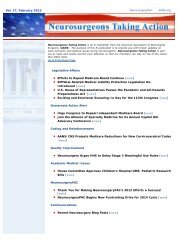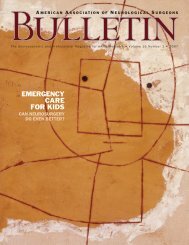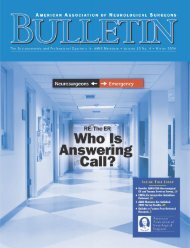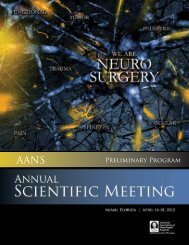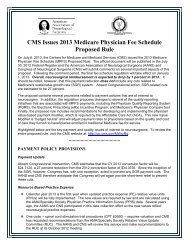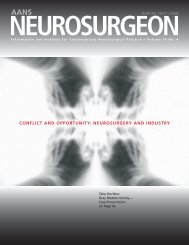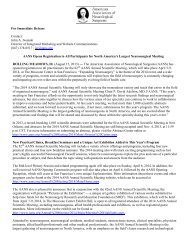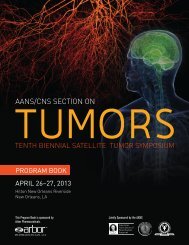view PDF - American Association of Neurological Surgeons
view PDF - American Association of Neurological Surgeons
view PDF - American Association of Neurological Surgeons
Create successful ePaper yourself
Turn your PDF publications into a flip-book with our unique Google optimized e-Paper software.
N<br />
N EWSLINEE<br />
WSLINE<br />
NewsMembersTrendsLegislation<br />
N E U R O N E W S<br />
.MD DOMAIN<br />
OFFICIALLY LAUNCHES<br />
A domain unique to<br />
members <strong>of</strong> the medical<br />
community, .md, <strong>of</strong>ficially<br />
launched in December.<br />
The .md domain differs<br />
from .com and .net<br />
domains in that it is<br />
dedicated to physicians,<br />
healthcare providers and<br />
medical organizations,<br />
allowing them to be<br />
located quickly by<br />
patients using the<br />
Internet. Additional<br />
information is available<br />
at www.maxmd.md.<br />
3 FDA Approves Device to Treat Lumbar Spinal Stenosis In November the U.S. Food and Drug<br />
Administration announced approval <strong>of</strong> a new titanium implant designed to limit extension <strong>of</strong> the spine<br />
in the area affected by lumbar spinal stenosis, which may relieve the painful symptoms if the disorder. The<br />
X-stop Interspinous Process Decompression System, invented by James Zucherman, MD, fits between the<br />
spinous processes. “By wedging those bones apart, the tube is indirectly opened up,” explained Dr.<br />
Zucherman in an Associated Press story. “The bones don’t collapse on the nerves like they did before [and]<br />
the patient doesn’t have to bend over to protect the nerves.” The X-stop is indicated for treatment <strong>of</strong><br />
patients age 50 or older who have been diagnosed with lumbar spinal stenosis, suffer from pain or cramping<br />
in the legs, and have undergone a regimen <strong>of</strong> at least six months <strong>of</strong> nonoperative treatment. Additional<br />
information is available at www.fda.gov/cdrh/mda/docs/p040001.html.<br />
3 Bone Marrow Stem Cell Approach Tested for Children With TBI A phase I trial underway in early 2006 is<br />
studying the safety and potential <strong>of</strong> treating children who have sustained traumatic brain injury with stem<br />
cells from their own bone marrow. The study at the University <strong>of</strong> Texas Medical School at Houston and<br />
Memorial Hermann Children’s Hospital involves extracting mesenchymal and hematopoietic stem cells<br />
from the bone marrow <strong>of</strong> each <strong>of</strong> 10 patients between the ages <strong>of</strong> 5 and 14, processing a stem cell preparation<br />
and giving it intravenously to the injured child, all within 48 hours <strong>of</strong> injury. “This would be an<br />
absolutely novel treatment, the first ever with potential to repair a traumatically damaged brain,” said neurosurgeon<br />
James Baumgartner, co-principal investigator on the project.<br />
3 Two Studies Explore Benefits and Risks <strong>of</strong> Vertebroplasty In two separate studies published in the<br />
<strong>American</strong> Journal <strong>of</strong> Neuroradiology, Mayo Clinic researchers report that patients with compression fractures<br />
are more functional for up to a year after vertebroplasty, but that the procedure may increase the risk<br />
<strong>of</strong> fracture in adjacent vertebrae. In the November–December issue <strong>of</strong> AJNR, Trout and colleagues report<br />
results <strong>of</strong> their retrospective re<strong>view</strong> <strong>of</strong> patients treated with vertebroplasty who had completed the Roland-<br />
Morris Disability Questionnaire at baseline and at four points during the year following the procedure.<br />
Patients’ pain during rest and activity improved an average <strong>of</strong> seven points one week after treatment and<br />
remained improved one year following treatment. In the January issue <strong>of</strong> AJNR, the researchers found<br />
that following vertebroplasty the risk <strong>of</strong> new fractures in adjacent vertebrae was 4.62 times the risk for<br />
nonadjacent vertebrae and that vertebrae adjacent to those treated with vertebroplasty fracture significantly<br />
sooner than more distant vertebrae. “This is not definitive evidence, but [it] should be considered<br />
when discussing risks with patients before embarking on vertebroplasty,” said David<br />
Kallmes, MD, senior study investigator.<br />
Send Neuro News briefs<br />
to the Bulletin,<br />
bulletin@AANS.org.<br />
3 Door Opens for Drugs That Turn Off Stroke-Induced Brain Damage A new study indicates that the EP1<br />
receptor on the surface <strong>of</strong> nerve cells is the switch that triggers brain damage caused by lack <strong>of</strong> oxygen during<br />
a stroke or seizure and that ONO-8713 is the compound that can turn the switch <strong>of</strong>f. The study, published<br />
in the January issue <strong>of</strong> Toxicological Sciences, found significant differences among mice whose ventricles<br />
were injected with EP1 stimulator ONO-DI-004, EP1 blocker ONO-8713, or the solvent used to<br />
carry the drugs. The volume <strong>of</strong> damage in mice treated first with ONO-8713 was only about 71 percent<br />
that <strong>of</strong> the control group injected with only the solvent. The researchers at Johns Hopkins University also<br />
showed that ONO-8713 can exert its influence only by binding to the EP1 receptor and that the stimulation<br />
<strong>of</strong> the EP1 receptors triggers the damage caused when blood flow is restored after a stroke. Researchers<br />
concluded that future efforts should focus on development <strong>of</strong> drugs that block the EP1 receptor.<br />
8 AANS Bulletin • www.AANS.org




